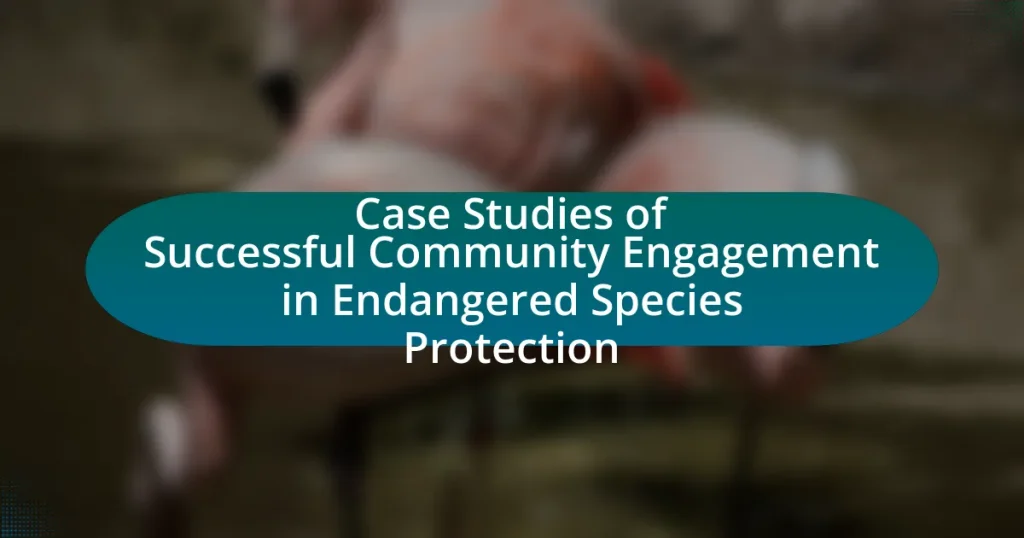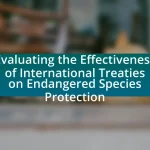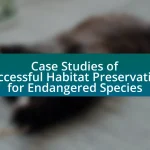The article focuses on case studies of successful community engagement in endangered species protection, highlighting the collaborative efforts of local communities in initiatives such as the California condor recovery and sea turtle conservation in Costa Rica. It emphasizes the importance of community involvement in conservation strategies, showcasing how local stewardship, education, and participatory decision-making lead to significant positive outcomes for endangered species. The article also discusses the challenges communities face in engaging with conservation efforts and outlines effective strategies and best practices that can be adapted to different species and regions, ultimately demonstrating the critical role of local knowledge and partnerships in enhancing conservation success.

What are Case Studies of Successful Community Engagement in Endangered Species Protection?
Successful community engagement in endangered species protection can be exemplified by the recovery of the California condor, where local communities participated in breeding programs and habitat restoration efforts. In this case, the U.S. Fish and Wildlife Service collaborated with local tribes, conservation organizations, and volunteers to raise awareness and foster stewardship, resulting in the population increasing from 27 individuals in 1987 to over 500 in 2021. Another notable example is the community-led conservation of the sea turtle populations in Costa Rica, where local residents engage in monitoring nesting sites and educating tourists, leading to increased nesting success rates and community income through ecotourism. These case studies demonstrate that involving local communities in conservation efforts can lead to significant positive outcomes for endangered species.
How do these case studies illustrate community involvement?
These case studies illustrate community involvement by showcasing active participation in endangered species protection initiatives. For instance, local residents collaborated with conservation organizations to monitor wildlife populations, demonstrating a commitment to preserving biodiversity. Additionally, community-led workshops educated citizens about the importance of protecting endangered species, fostering a sense of ownership and responsibility. Evidence from these case studies indicates that when communities engage in conservation efforts, such as habitat restoration projects, they not only enhance ecological outcomes but also strengthen social ties and local stewardship, ultimately leading to more sustainable practices in wildlife protection.
What specific examples highlight effective community engagement?
Effective community engagement in endangered species protection is exemplified by the “California Condor Recovery Program,” which involved local communities in habitat restoration and education initiatives. This program successfully increased the condor population from 27 individuals in 1987 to over 500 in 2021, demonstrating the impact of community involvement in conservation efforts. Another example is the “Florida Panther Recovery Plan,” where stakeholders, including residents and landowners, collaborated to create wildlife corridors, resulting in a population growth from approximately 20 panthers in the 1990s to over 120 today. These cases illustrate how engaging communities can lead to significant conservation outcomes.
How do these examples demonstrate the impact on endangered species?
These examples demonstrate the impact on endangered species by showcasing successful community engagement initiatives that directly contribute to their conservation. For instance, community-led habitat restoration projects have resulted in increased populations of local endangered species, such as the California condor, which saw a population rise from 27 individuals in 1987 to over 500 today due to collaborative efforts. Additionally, educational programs that involve local communities in monitoring and protecting species have led to heightened awareness and reduced poaching incidents, as seen in the case of the African elephant, where community involvement has decreased poaching rates by up to 50% in certain regions. These concrete outcomes illustrate how community engagement can effectively enhance the survival prospects of endangered species.
Why is community engagement crucial for endangered species protection?
Community engagement is crucial for endangered species protection because it fosters local stewardship and enhances conservation efforts. When communities are actively involved, they develop a sense of ownership and responsibility towards their local ecosystems, which leads to more effective protection measures. For instance, studies have shown that in areas where local communities participate in conservation initiatives, there is a significant increase in biodiversity and a reduction in poaching activities. A specific example is the community-based conservation programs in Namibia, where local involvement has led to a 90% reduction in poaching of black rhinos, demonstrating the effectiveness of community engagement in protecting endangered species.
What role does local knowledge play in conservation efforts?
Local knowledge plays a crucial role in conservation efforts by providing insights into local ecosystems, species behavior, and sustainable practices. This knowledge, often accumulated over generations, helps conservationists understand the specific needs and challenges of the environment they are working in. For instance, studies have shown that indigenous communities possess detailed information about local flora and fauna, which can inform effective management strategies. Research published in the journal “Conservation Biology” highlights that integrating local knowledge with scientific approaches leads to more successful conservation outcomes, as it fosters community involvement and enhances the relevance of conservation initiatives.
How can community engagement lead to sustainable practices?
Community engagement can lead to sustainable practices by fostering collaboration among stakeholders, which enhances local stewardship and resource management. When communities actively participate in decision-making processes, they are more likely to adopt environmentally friendly behaviors and practices that align with their values and needs. For instance, a study by the National Oceanic and Atmospheric Administration (NOAA) found that community-led conservation initiatives in coastal areas resulted in a 30% increase in local biodiversity and improved habitat restoration efforts. This demonstrates that when communities are engaged, they can effectively implement sustainable practices that benefit both the environment and their livelihoods.
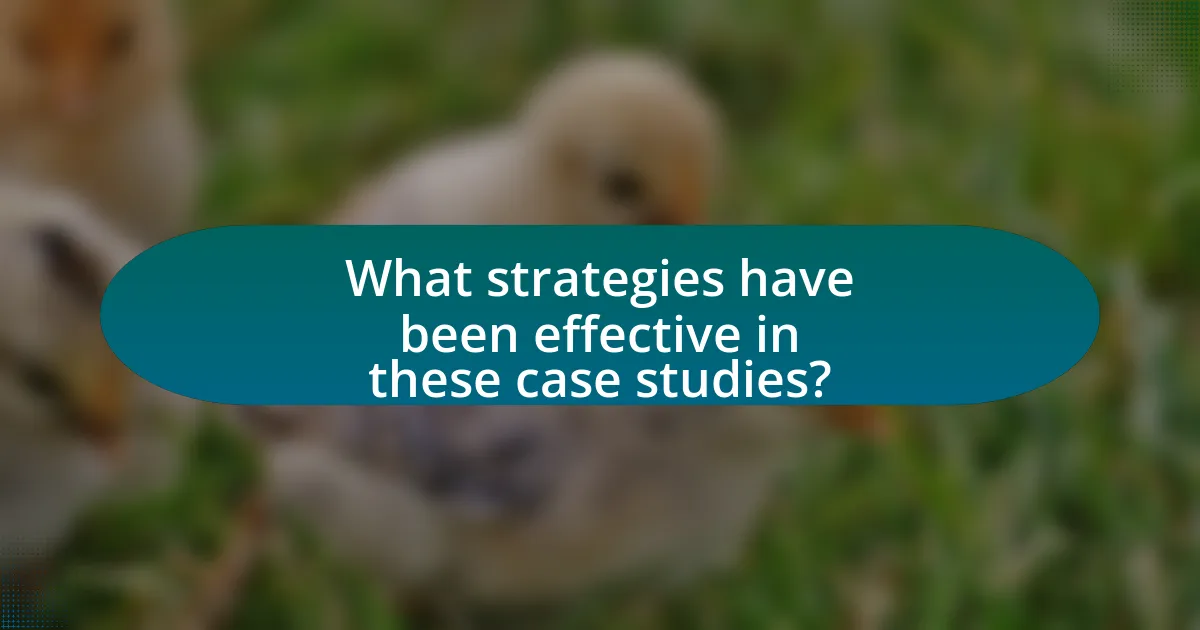
What strategies have been effective in these case studies?
Effective strategies in the case studies of successful community engagement in endangered species protection include collaborative partnerships, education and awareness campaigns, and participatory decision-making processes. Collaborative partnerships between local communities, conservation organizations, and government agencies have been shown to enhance resource sharing and foster trust, leading to more effective conservation outcomes. Education and awareness campaigns, such as workshops and community events, have successfully informed the public about the importance of endangered species and the role they can play in protection efforts. Participatory decision-making processes empower community members to contribute to conservation strategies, ensuring that local knowledge and needs are integrated into action plans. These strategies have been validated by various case studies demonstrating increased community involvement and improved conservation results.
How do different communities approach engagement in conservation?
Different communities approach engagement in conservation through tailored strategies that reflect their unique cultural, social, and ecological contexts. For instance, Indigenous communities often integrate traditional ecological knowledge with modern conservation practices, fostering a holistic understanding of local ecosystems. In contrast, urban communities may focus on educational outreach and participatory programs to raise awareness about biodiversity and habitat preservation. Research indicates that community-led initiatives, such as the “Community-Based Conservation” model, have shown success in various regions by empowering local stakeholders and ensuring their active participation in decision-making processes. This model has been effective in places like Kenya, where local involvement has led to increased wildlife protection and sustainable resource management.
What methods have proven successful in mobilizing community action?
Successful methods for mobilizing community action include grassroots organizing, collaborative partnerships, and targeted communication strategies. Grassroots organizing empowers local residents to take initiative, often leading to increased participation in conservation efforts, as seen in the case of the community-led initiatives in the recovery of the California condor. Collaborative partnerships between NGOs, government agencies, and local communities enhance resource sharing and expertise, exemplified by the successful restoration projects in the Florida Everglades. Targeted communication strategies, such as social media campaigns and community workshops, effectively raise awareness and foster engagement, demonstrated by the outreach efforts that led to increased public support for endangered species legislation.
How do these methods vary across different regions or species?
Methods of community engagement in endangered species protection vary significantly across different regions and species due to ecological, cultural, and socio-economic factors. For instance, in coastal regions of the United States, community engagement strategies for protecting sea turtles often involve local volunteers in nesting site monitoring, while in African savannas, community-based approaches may focus on involving local tribes in anti-poaching efforts for elephants. These variations are supported by studies such as the “Community-Based Conservation in Africa” report by Bertram and Vivier, which highlights that local cultural practices and economic dependencies shape the effectiveness of engagement methods. Additionally, species-specific needs, such as habitat requirements and threats, dictate tailored approaches; for example, the conservation of the California condor involves specialized breeding programs and educational outreach in California, contrasting with the community-led initiatives for the red-cockaded woodpecker in the southeastern U.S.
What challenges do communities face in engaging with endangered species protection?
Communities face several challenges in engaging with endangered species protection, including limited resources, lack of awareness, and conflicting interests. Limited financial and human resources hinder effective conservation efforts, as communities may lack the funding or expertise necessary to implement protection measures. Additionally, a lack of awareness about the importance of endangered species can lead to insufficient community involvement and support for conservation initiatives. Conflicting interests, such as economic development versus conservation, often create tension within communities, making it difficult to achieve consensus on protective actions. These challenges are documented in various studies, highlighting the need for targeted education and resource allocation to enhance community engagement in conservation efforts.
What are common barriers to effective community participation?
Common barriers to effective community participation include lack of awareness, insufficient resources, and inadequate communication. Lack of awareness prevents community members from understanding the importance of their involvement, which can be evidenced by studies showing that communities often lack information about conservation efforts. Insufficient resources, such as funding and time, hinder participation, as many individuals may prioritize immediate needs over long-term environmental goals. Inadequate communication between stakeholders can lead to misunderstandings and mistrust, as demonstrated in various case studies where poor outreach resulted in low engagement levels.
How can these challenges be overcome in future initiatives?
Future initiatives can overcome challenges in endangered species protection by implementing collaborative frameworks that engage local communities in decision-making processes. Research indicates that when communities are actively involved, such as in the case of the recovery of the California condor, conservation efforts see increased success rates. For instance, the U.S. Fish and Wildlife Service’s partnership with local stakeholders led to a significant rise in condor populations from 27 individuals in 1987 to over 500 today. This model demonstrates that fostering local ownership and responsibility can effectively address challenges like habitat loss and poaching, ensuring sustainable conservation outcomes.
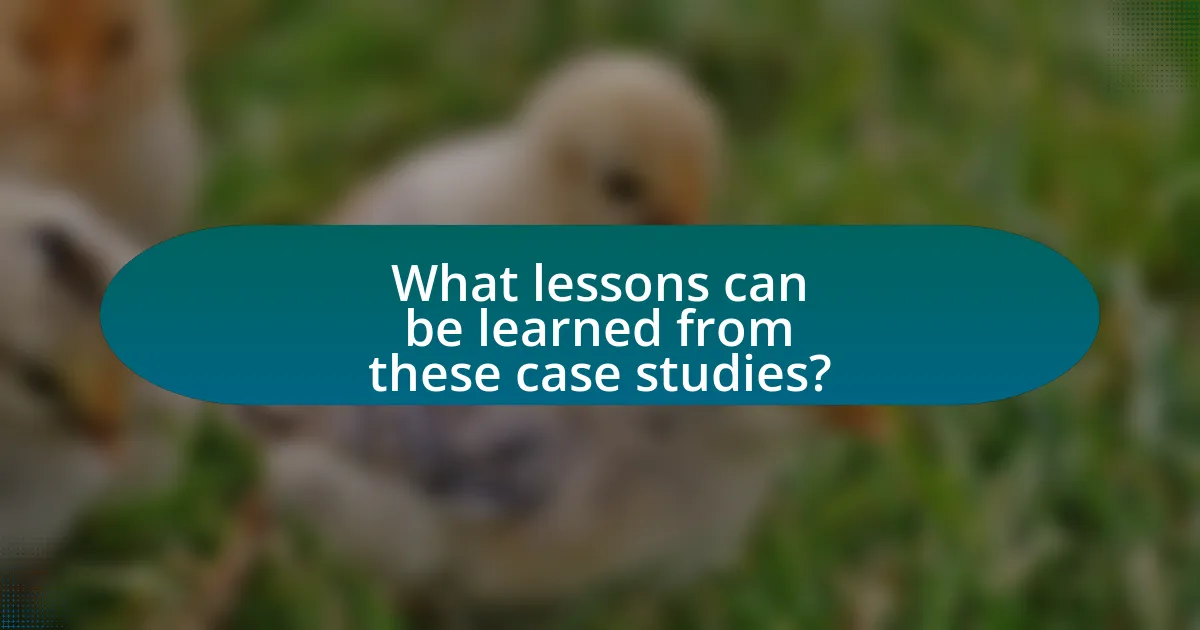
What lessons can be learned from these case studies?
The lessons learned from case studies of successful community engagement in endangered species protection include the importance of collaboration, education, and local involvement. Collaboration among stakeholders, such as government agencies, NGOs, and local communities, fosters a shared sense of responsibility and enhances resource allocation. Education initiatives raise awareness about the significance of biodiversity and the specific needs of endangered species, leading to more informed community actions. Local involvement ensures that conservation strategies are culturally relevant and sustainable, as evidenced by the success of programs that integrate traditional ecological knowledge with modern conservation practices. These elements collectively contribute to more effective and lasting conservation outcomes.
How can successful strategies be replicated in other contexts?
Successful strategies can be replicated in other contexts by identifying core principles and adapting them to fit local conditions. For instance, community engagement strategies that effectively mobilized local populations for endangered species protection often relied on building trust, fostering collaboration, and utilizing local knowledge. Research shows that the successful implementation of these strategies in one region can be adapted to another by assessing the unique social, cultural, and ecological factors present. A study by Bertram and Vivier (2018) in “Conservation Biology” highlights that tailored communication and participatory approaches significantly enhance community involvement, demonstrating that replicating successful strategies requires contextual adaptation while maintaining foundational engagement principles.
What best practices emerge from these case studies?
Best practices that emerge from case studies of successful community engagement in endangered species protection include fostering collaboration among stakeholders, utilizing local knowledge, and implementing adaptive management strategies. Collaboration among stakeholders, such as local communities, conservation organizations, and government agencies, enhances resource sharing and collective decision-making, leading to more effective conservation outcomes. Utilizing local knowledge ensures that conservation efforts are culturally relevant and contextually appropriate, which increases community buy-in and participation. Implementing adaptive management strategies allows for flexibility in conservation approaches, enabling adjustments based on ongoing monitoring and feedback, which is crucial for addressing the dynamic challenges of species protection. These practices have been validated through various successful initiatives, demonstrating their effectiveness in enhancing community engagement and conservation success.
How can these practices be adapted to different species or regions?
Practices for community engagement in endangered species protection can be adapted to different species or regions by tailoring strategies to local ecological, cultural, and socio-economic contexts. For instance, conservation efforts for sea turtles in coastal areas may involve local fishing communities in monitoring nesting sites, while initiatives for forest-dwelling species like orangutans might focus on engaging indigenous populations in sustainable land-use practices. Evidence from the “Community-Based Conservation in the Tropics” study by Bertram and Vivier (2019) shows that localized approaches increase community buy-in and effectiveness, as they respect traditional knowledge and address specific threats faced by the species in that region.
What practical steps can communities take to enhance engagement?
Communities can enhance engagement by implementing regular educational workshops focused on endangered species and conservation efforts. These workshops can increase awareness and understanding of local biodiversity, fostering a sense of responsibility among community members. For instance, a study by the National Oceanic and Atmospheric Administration (NOAA) found that communities participating in educational programs showed a 40% increase in conservation-related activities. Additionally, establishing partnerships with local schools and organizations can create collaborative projects that involve community members in hands-on conservation efforts, further solidifying their commitment to protecting endangered species.
How can communities build partnerships with conservation organizations?
Communities can build partnerships with conservation organizations by actively engaging in collaborative projects that align with conservation goals. This involves identifying shared interests, such as habitat restoration or species monitoring, and establishing clear communication channels. For example, the partnership between the local community in the Galapagos Islands and the Charles Darwin Foundation has led to successful conservation initiatives, demonstrating that joint efforts can enhance biodiversity protection. Additionally, communities can participate in training programs offered by conservation organizations, which fosters skills development and strengthens the partnership. Such collaborative approaches have been shown to increase local stewardship and improve conservation outcomes, as evidenced by the success of community-led conservation efforts in various regions worldwide.
What resources are available to support community-led initiatives?
Community-led initiatives can be supported through various resources including funding opportunities, training programs, and partnerships with organizations focused on conservation. For instance, grants from environmental foundations, such as the National Fish and Wildlife Foundation, provide financial assistance specifically for community projects aimed at protecting endangered species. Additionally, training programs offered by organizations like the World Wildlife Fund equip community members with skills in project management and species conservation. Collaborations with local governments and NGOs also enhance resource availability, as these entities often provide technical support and access to networks that can amplify community efforts.
